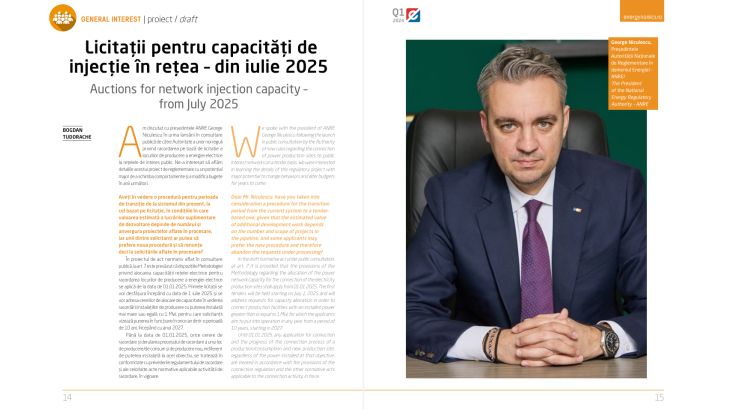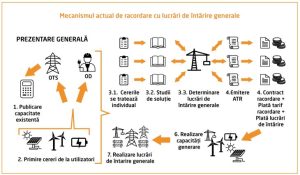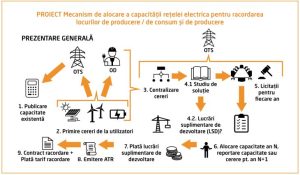We spoke with the president of ANRE George Niculescu following the launch in public consultation by the Authority of new rules regarding the connection of power production sites to public interest networks on a tender basis. We were interested in learning the details of this regulatory project with major potential to change behaviors and alter budgets for years to come.
Dear Mr. Niculescu, have you taken into consideration a procedure for the transition period from the current system to a tender-based one, given that the estimated value of additional development work depends on the number and scope of projects in the pipeline, and some applicants may prefer the new procedure and therefore abandon the requests under processing?
In the draft normative act under public consultation, at art. 7 it is provided that the provisions of the Methodology regarding the allocation of the power network capacity for the connection of the electricity production sites shall apply from 01.01.2025. The first tenders will be held starting on July 1, 2025 and will address requests for capacity allocation in order to connect production facilities with an installed power greater than or equal to 1 MW, for which the applicants aim to put into operation in any year from a period of 10 years, starting in 2027.
Until 01.01.2025, any application for connection and the progress of the connection process of a production/consumption and new production site, regardless of the power installed at that objective, are treated in accordance with the provisions of the connection regulation and the other normative acts applicable to the connection activity, in force.
Therefore, projects in any of the stages of the ongoing connection process are not affected by the new provisions. If a user who holds a valid technical approval for connection or an ongoing connection contract were to opt out and choose to apply the new provisions, this would entail the loss of the approved power guaranteed by the connection approval, respectively the capacity reserved in the network.
According to the draft normative act, before submitting applications for capacity allocation, applicants are informed about the available network capacity for which it is not necessary to carry out additional development works to create the technical conditions in order to evacuate the produced power, as well as about the areas of network where this capability is available. Such available capacity is allocated at no cost to applicants. The volume of additional development works and their estimated value will depend on the orientation of future network users to a particular area.
The methodology describes the stages preceding the auction (calculation of available capacities, submission of allocation requests by applicants, elaboration of the global solution study that establishes the additional development works required to cover the capacity requested for allocation for connection and their value).
At the same time, this includes provisions regarding the organization of tenders, the establishment by applicants of guarantees for participation in tenders, the submission of offers, as well as rules regarding the allocation of available capacities, in different situations that may arise during the allocation procedure.
The methodology is under public debate on the ANRE website, comments are received from those interested, after we have a meeting to discuss the comments, the final form of the draft normative act will be drawn up. We will carefully analyze all observations and proposals in order to develop an optimal form that will be to the advantage of all those who wish to carry out projects with installed capacities of electricity production facilities greater than or equal to 1 MW and who will access this mechanism for allocating power grid capacity for connecting generation/consumption and generation sites.
How do you see it possible to recalculate the estimated value of the additional work needed to develop the network so that it takes into account the dynamics of ATR requests (expirations, signed contracts, etc.)?
The value of the additional development works is paid by the winning participants of the auctions, who signed the allocation contracts, no later than 4 months from the date of signing the allocation contract.
The sums collected from the future users of the electricity network are used by the network operators exclusively for carrying out the development works of the electricity networks intended to increase the capacity necessary to connect new electricity production capacities.
Once the respective amounts have been collected, the additional development works must be carried out by the network operators involved, having the commissioning term stipulated in the allocation contract and are no longer affected by the dynamics of requests for technical approvals for connection from the users. Surplus money after bidding and carrying out additional development works is used by network operators exclusively to finance other development works.
I emphasize the fact that the future users also have the obligation to complete the works related to the objectives at the production sites and to put the user facilities into operation by the terms stipulated in the allocation contracts, terms taken into account when determining the need for additional works development of the electrical network.
It is also important to specify that any capacities that become available through waivers, expiration of ATRs, etc. it is added to the next year’s auctions.
The total estimated value of the additional development works excludes the economically efficient value of the works, established in accordance with the provisions of the regulations in force, which is borne by the transmission and system operator and/or the distribution operators as the case may be, and which could have minimal impact on the tariffs for the provision of the electricity transmission service, respectively for the provision of the electricity distribution service depending on the resulting efficiency ratio.
In conclusion, there is the option where this efficiency rate is zero, so distribution rates will not be impacted, but there is also the scenario where it could have a minimal impact on rates.
In the calculation of the estimated value of the additional works required for the development of the network, an important weight is given to the ongoing network development works by the TSO and the DSO. What will be the mechanism by which it will be possible to take into account the actual stage of the works and the deadlines for completion? The latter are often postponed, sometimes following developments that cannot be anticipated by the TSO or DSO.
Both the rules currently applied to the connection of the production sites, as well as the mechanism for allocating the available capacity of the electric network proposed by the draft normative act, take into account the network development works, the deadlines for which are assumed by the network operators through own development plans and subsequently through their annual investment plans.
Through the normative acts issued, at ANRE we have created the necessary mechanisms through which the network operators comply with the implementation of the approved investment plans, as the acceptance by ANRE of the investments is carried out according to criteria that include the supporting documents for their completion at the deadlines provided in the plan. The values of the works from the operators’ investment plans are recognized in the network tariffs, so the postponement or delay in their realization has effects on their level.
The first stage in the capacity allocation procedure by auction is the publication of the available capacity in the RET and in the RED at the 110 kV and medium voltage level, which does not include capacity from additional development works, for each year of the period of allocation and for each network area. It is obvious that it is mandatory that the works to achieve the respective capacity are completed and the capacity is put into operation in the year in which it was communicated as available to take over the power discharged from the production site.
At the same time, an important aspect is that the need for additional development works and their estimated value depend on the available capacity in each year of the allocation period and the volume of allocation requests for production sites with commissioning also corresponding to each year of the period allocation, in each network area.
Do you currently have an estimate of nominal values of guarantees of 5% of the value of the connection tariff or at least a range of nominal values per installed MW?
It is difficult to estimate and I think that a nominal value of the guarantees per installed MW is not relevant because the connection solutions of the consumption and/or production sites, even those with similar powers approved for consumption and/or discharge, can be very different according to the possibilities of the network to ensure the consumption or to take over the discharged power under safe conditions. As a result, the value of the connection fee can also vary greatly depending on the connection solution.
Do you anticipate any risk that the new methodology to be introduced will delay or block ongoing investments? What kind of measures do you have in mind to minimize these risks?
As I said before, the new methodology is based on two principles: the establishment of a guarantee of 5% of the value of the ATRs, something to prove the investor’s interest in making that investment, and another one of granting technical approvals for the connection according to a principle of the auction, so a competitive framework between those wanting power installed in the distribution and transmission networks to be competitive, depending on the availability that will be shown by a global solution study that we proposed to be carried out by colleagues from Transelectrica .
Regarding the postponement or blocking of some ongoing investments, we appreciate that the new methodology will not influence them in any way, because for those investments the connection process is ongoing and technical connection notices are issued whereby the power approved for evacuation is guaranteed throughout the period of validity of the approval and that of the connection contract, until the connection certificate is issued.
I remind you that this connection certificate is the unique document that certifies the fulfillment of the conditions for connection to the network, the realization of the connection installation and that of use, and which establishes the technical conditions for using the electrical network after the final energization of the installation use.
It is valid throughout the life of the user installation and must include, in the case of a production site, the power approved for evacuation.
At the same time, the capacity available in RET and RED at the voltage level of 110 kV and at medium voltage, which does not include capacity from additional works and which will be published at the beginning of each tender year, will be determined based on the provisions of a procedure issued also by ANRE, which applies as of March 2022 for the 110 kV transmission and distribution networks. In this way, continuity is ensured in the application of the same rules, known to future users of the network, who intend to connect new production sites to the network.
The risks are also minimized by the fact that the procedure establishes the mandatory criteria for calculating the available capacity, such as:
- the use of technical data/characteristics of RET and RED in operation at the time of the calculation,
- the electrical installations related to the works included in the development/investment plans of the transmission and system operator and/or distribution operators in the commissioning stage,
- the nominal capacity of the generating units under voltage, as well as those for which technical approvals have been issued for connection without work to strengthen the electrical network upstream of the connection point, within the validity period,
- the consumption of RET and RED users in operation and those with technical approvals for connection within the validity period technical characteristics of the network (voltage variations, admissible limits of short-circuit currents,
- keeping automation equipment settings unchanged, etc.
The calculation method is unique, so that the values of the capacities resulting from the calculations can be compared between the concession areas, at the same network voltage level.
The costs of the additional work required to develop the grid are one of the key elements that impact the final investment decision for a large renewable electricity generation project. The operationalization of the cross-border guarantee of origin market would reduce the pressure felt by developers and improve the bankability calculations and estimated financial performances of the projects. When do you estimate that projects in Romania will be able to benefit from this type of instruments, through the full accession of our country to the European system managed by AIB?
Regulation on the issuance and tracking of guarantees of origin for electricity produced from renewable energy sources, approved by HG no. 1232/2011, establishes the national legal framework applicable to the system of guaranteeing electricity produced from SRE, through guarantees of origin.
Government decisions are approved and amended by the Government of Romania, at the proposal of the competent ministry, as a result the institution responsible for regulating and amending the primary framework related to guarantees of origin (GO) is the Ministry of Energy and/or the General Secretariat of the Government.
ANRE as the issuing entity of GO, in collaboration with the Ministry of Energy, is part of the working group for the modification and completion of the related regulation, with the provisions of the primary legislation transposing RED II, relevant on this subject.
On the other hand, considering the fact that ANRE does not have the right of legislative initiative, it can only be consulted, we have already expressed our willingness to contribute to the adjustment of the primary regulation to clarify the legal framework that regulates GO. In this sense, ANRE’s proposal is for Romania to join the association that facilitates cross-border GO transfers and/or transactions (AIB).
Consequently, the time perspective depends on the fulfillment of some conditions, such as those previously mentioned, namely the modification of the legal framework and the accession to the AIB, which represents a staged process, initially as an observer member, and later as a full member.
_____________________________________________
This interview first appeared in the printed edition of Energynomics Magazine, issued in March 2024.
In order to receive the printed or electronic issue of Energynomics Magazine, we encourage you to write us at office [at] energynomics.ro to include you in our distribution list. All previous editions are available HERE.


